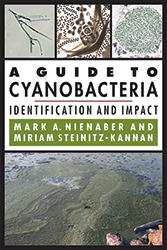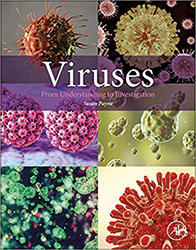Reviews
Issue: Oceans
05 February 2019 article


A Guide to Cyanobacteria: Identification and Impact
Written by Mark A. Nienaber and Miriam Steinitz-Kannan
$20.00 ISBN: 978-0-8131-7561-4
Most members of the public are not aware of the important role cyanobacteria play in the environment. This is an excellent book which provides a useful introduction to these organisms for members of the general public interested in ecology and microbiology. Included is a useful introduction on cyanobacterial physiology, including some of the toxins produced by certain species which can impact human and animal health. More detailed information on the physiological characteristics of different cyanobacteria is provided for academics trying to identify strains in the environment, or individuals working in industries affected by cyanobacterial outbreaks, such as farmers and water companies. This is aided by clear descriptions and photos. I would thoroughly recommend this book for anyone interested in these fascinating organisms.
Dr David Lea-Smith
University of East Anglia
The below reviews are published online in addition to those in the print or PDF copy of this issue of Microbiology Today.

Climate Change and Microbial Ecology: Current Research and Future Trends
Edited by: Jürgen Marxsen
Caister Academic Press (2016)
£159 ISBN: 978-1-910190-31-9
Climate Change and Microbial Ecology reviews the effect of global climate change on microorganisms and the reverse effects of climate change on microbes. The authors deliberate that while microbial production of climate gases such as carbon dioxide, methane and nitrous oxide can influence global climate change; the reverse response of microbes from human-caused effects on climate can be varied and may not be conclusive.
The book has been divided into two major sections with additional chapters on applied aspects of climate change and microbial ecology. In the first section, the book focuses on how climate change impacts different aquatic ecosystem-specific microbes, such as cyanobacteria, bacteria and protozoans from marine environments, and freshwater fungi, macrofungi, virus and microbial biofilms in the aquatic environment. Global climate change could influence diverse microbial events such as cyanobacterial bloom, increased abundance of pathogenic bacteria, complex microbial food web interactions, aquatic hyphomycetes activity and structure, virus driven processes such as assembly and interaction with hosts and changes in biofilm community structure and composition of extracellular polymeric substances in the aquatic environment.
The second section of the book covers consequence of climate change on microbes in biogeochemical cycles including nitrogen cycling and turnover in soils and aquatic environment, proposed mechanisms and models of soil carbon balance and cycling, carbon metabolism in river networks and impact on soil microbial community composition and metabolism. The authors suggest that integrating simulation model with field data can facilitate greater understanding of microbial processes and can assist building new generation of soil carbon models. An understanding of microbial feedback to climate change is essential to our broad understanding of the role of microbial communities to global climate change.
The last two chapters cover applied aspects of microbial ecology and climate change. The first chapter of this applied section covers the combined impact of land-use change and climate change on microbial diversity composition in the tropics. The last chapter of the book focuses on peatland geoengineering for manipulation of microbial activities to maximize carbon storage and capture and thus potentially alleviate the anthropogenic climate change.
The book is a comprehensive, timely and authoritative review on the increasingly important area of global climate change and microbial ecology. This volume will serve as an excellent resource for graduate students, microbial ecologists, climate scientists, policy makers and anyone who might be interested in the field of global climate change.
Arindam Mitra
Adamas University

Viruses: From Understanding to Investigation (1st Edition)
Written by S. Payne
Academic Press (2017)
£98.85 ISBN 978-0128031094
As a masters degree Programme Leader, I like to keep abreast with the latest textbooks in my area and I am aware of four, fairly similar, although very good, virology textbooks that have been published over the last couple of years. Viruses: From Understanding to Investigation is now the fifth. I must admit, I’m still a little perplexed by the title. It isn’t so different from the other recently-published textbooks, and is probably most similar to Molecular Virology of Human Pathogenic Viruses by W. Ryu, also published by Academic Press. In my opinion, the most significant difference between these books is that Viruses: From Understanding to Investigation is almost twice the price at time of writing. One might be prepared to pay extra for a more up-to-date book, but since these books are only a year apart, I do not understand why there is such difference in price. Having said that, Viruses: From Understanding to Investigation is a very good virology textbook, covering viral structures, interactions with the host cell, techniques used to study viruses, transmission, immunity, evolution and pathogenesis, before focusing in on details of each family of RNA and DNA viruses. The illustrations are very clear and engaging, making it a very attractive and informative textbook. I’m sure that enthusiastic undergraduate and postgraduate students will find this book very helpful in their understanding and investigation of viruses, but if they do purchase a textbook, I strongly suspect they will opt for a cheaper one.
Christopher Ring
Middlesex University
